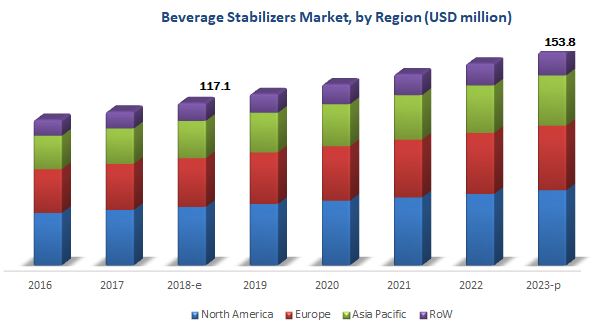The beverage stabilizers market is estimated at USD 117.1 million in 2018, and is projected to grow at a CAGR of 5.6% to reach a value of USD 153.8 million by 2023. Beverage stabilizers impart textural properties, physical functionalities, or physical stability to the products. They primarily stabilize oil and water emulsions. Beverage stabilizers are essential food additives that have been used by food & beverage manufacturers to maintain the end-product stability, texture, shape, and color.

Objectives of the study are as follows:
- To define, segment, and measure the beverage stabilizers market with respect to its type, application, function, and region
- To provide detailed information about the major factors influencing the growth of the market (drivers, restraints, opportunities, and industry-specific challenges)
- To analyze the complete value chain and supply chain of beverage stabilizers
- To analyze the opportunities in the market for stakeholders and provide details of the competitive landscape for market leaders
- To profile the key players and comprehensively analyze their core competencies
- To analyze the competitive developments-new product developments, mergers & acquisitions, investments, expansions, joint ventures, collaborations, and supply contracts-in the beverage stabilizers market
- To profile the key beverage stabilizers companies with respect to the business overview, recent financials, segmental revenue mix, geographic presence, and information about the products & services
Download PDF Brochure: https://www.marketsandmarkets.com/pdfdownloadNew.asp?id=87923328
The worldwide demand for beverage stabilizers is on the rise, particularly in the fruit drinks industry. The demand is governed by the performance quality and functionality of the products. Increasing demand for beverage stabilizers is one of the factors supporting market development and significant innovation.
The stabilization segment is estimated to account for the largest share in the beverage stabilizers market in 2018.
The stabilization segment is projected to dominate this market through the forecast period. The dominance of this segment can be attributed to the increased consumption of nutritional beverages with reduced calorie levels that require beverage stabilizers & systems. The function of beverage stabilizers such as hydrocolloids is to stabilize the emulsion, prevent separation, and, in the case of wine and other alcoholic beverages, to control ice crystal formation.
North America is estimated to dominate the beverage stabilizers market in 2018.
The North American region is estimated to form the largest market for beverage stabilizers in 2018. North American consumers are considered to be more health-conscious and pay close attention to the ingredients used in the food products and medicine they consume. The demand for natural food ingredients influences the buying behavior of key food & beverage manufacturers in the market. The potential demand for beverage stabilizers is further driven by the foodservice industry in the region.
Speak to Analyst: https://www.marketsandmarkets.com/speaktoanalystNew.asp?id=87923328
This report includes a study of marketing and development strategies, along with the product portfolios of the leading companies. It includes profiles of leading companies such as Cargill (US), Tate & Lyle (UK), DowDuPont (US), Ashland (US), Palsgaard (Denmark), Glanbia Nutritionals (US), Kerry Group (Ireland), Advanced Food Systems (US), Chemelco International (Netherlands), and Nexira (France).
Targeted Audience:
- Food & beverage suppliers and manufacturers
- Food & beverage importers and exporters
- Food & beverage traders and distributors
- Government and research organizations
- Associations and industry bodies [World Health Organization (WHO), ICBA (International Council of Beverage Associations), American Beverage Association (ABA), and Global Food & Beverage Association (GFBA)]